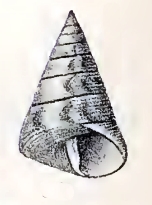Biology:Calliostoma gualterianum
| Calliostoma gualterianum | |
|---|---|

| |
| Drawing of a shell of Calliostoma gualterianum | |
| Scientific classification | |
| Domain: | Eukaryota |
| Kingdom: | Animalia |
| Phylum: | Mollusca |
| Class: | Gastropoda |
| Subclass: | Vetigastropoda |
| Order: | Trochida |
| Superfamily: | Trochoidea |
| Family: | Calliostomatidae |
| Genus: | Calliostoma |
| Species: | C. gualterianum
|
| Binomial name | |
| Calliostoma gualterianum (Philippi, 1848) [1]
| |
| Synonyms | |
Calliostoma gualterianum, common name Gualtieri's top shell, is a species of sea snail, a marine gastropod mollusk in the family Calliostomatidae.[4]
Description
The size of the shell varies between 10 mm and 17 mm. The imperforate, polished, solid shell has a conical-elevated shape with 9 whorls. It is yellowish-brown or olive, clouded with brown, the earlier 4 whorls dark bluish or greenish. The shell is spirally sulcate, the 2d whorl somewhat granulate. The rest of the whorls are smooth, flat, and with a narrow supra-sutural fasciole, which on the body whorl is not developed. The periphery is rounded angular. The base of the shell is smooth except for about 4 fine riblets around the axis. The aperture is smooth within. The nacreous columella is a trifle swollen at its base, and either purple or whitish inside.[5]
Distribution
This species occurs in the Mediterranean Sea.
References
- ↑ Philippi., in Conchyl. Cab., p. 69, t. 13,'f. 15.
- ↑ Fischer, Coq. Viv., p. 404, 1. 119, f. 5.
- ↑ Weinkauff, Conchyl. des Mittelm. ii, p. 361
- ↑ Calliostoma gualterianum (Philippi, 1848). Retrieved through: World Register of Marine Species.
- ↑ Tryon (1889), Manual of Conchology XI, Academy of Natural Sciences, Philadelphia
- Gofas, S.; Le Renard, J.; Bouchet, P. (2001). Mollusca, in: Costello, M.J. et al. (Ed.) (2001). European register of marine species: a check-list of the marine species in Europe and a bibliography of guides to their identification. Collection Patrimoines Naturels, 50: pp. 180–213
External links
- "Calliostoma (Calliostoma) gualterianum" (in en). Gastropods.com. http://www.gastropods.com/0/Shell_2350.shtml.
Wikidata ☰ Q5022346 entry
 |

